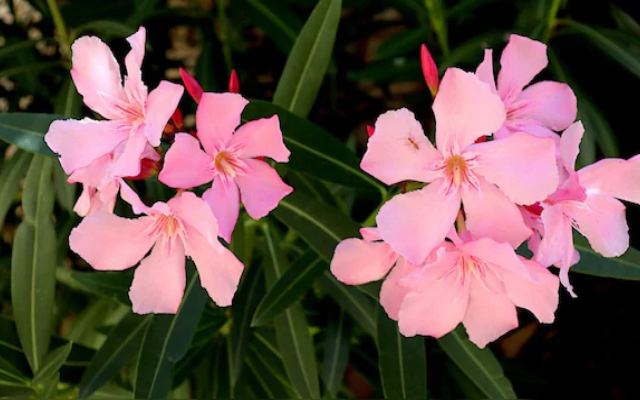Oleander flowers, known for their vibrant blooms ranging from white and pink to red and yellow, are a staple in gardens and landscapes. But did you know they can be fatal and are now banned by more than 2,000 temples in Kerala?
While the flower is alluring, it has created fear in the state after some tragic incidents of poisoning surfaced. A 24-year-old woman died on 29 April from suspected poisoning from oleander leaves, which she accidentally consumed in her Alappuzha house.
The shocking cases from Kerala.
Soorya Surendran was about to board a flight from Kochi International Airport to join a nurse job last week. However, her health deteriorated on the way, she collapsed and suffered a heart attack, according to a report in The Deccan Herald.
Haripad police inspector K Abilash Kumar, who is probing the death, said that doctors who treated Soorya said she suffered poisoning from oleander, commonly known as Arali leaves. “She accidentally chewed some oleander leaves while she was speaking to someone over the phone at her house before leaving for the airport. We are awaiting a final report,” he told The Indian Express.
Soorya was admitted to the hospital, where she passed away the next day.
However, this is not the first case of oleander poisoning. A resident of Thengamam in south Kerala’s Pathanamthitta reported that her cow and its calf fell ill and ultimately died after consuming the leaves that were inadvertently mixed with grass collected from nearby areas.
The ban on oleander flowers in Kerala temples
After Surendran’s death, two government-run temple boards in the state banned the use of oleander flowers. They cannot be used in food offered to the deity and prasad to devotees.
The Travancore Devaswom Board (TDB), which is at the helm of 1,200-odd temples, and the Malabar Devaswom Board (MDB), which oversees 1,300-odd temples took this decision.
“Instead, the devotees should offer other flowers such as tulsi, thechi, and rose for naivedhya and prasadam. The same (oleander) flowers can be used for puja at temples. The decision is meant to ensure that oleander flowers do not reach the hands of devotees…,” TDB president PS Prasanth told The Indian Express.
The use of oleanders
With their fragrant blossoms, the evergreen oleander shrubs reach heights of 18-20 feet. For generations, these blooms have been commonly used in Indian pujas. These sizable bushes, adorned with clusters of single or double flowers measuring two inches, dominate landscapes from early summer to mid-autumn.
Termed as “desert rose” in ancient texts, oleander has been trusted with its medicinal properties such as a hangover cure, in cancer treatments, and as an antiviral. Romans and Arabs also valued its healing potential for various ailments, say reports.
As per the US National Institutes of Health, oleanders can also be used against asthma, epilepsy, painful menstrual periods, malaria, skin problems, warts, ringworm, and indigestion. However, like many botanical remedies, oleander carries a deadly edge. Its raw extracts are highly toxic and should never be ingested without proper preparation.
“Oleander is a plant that has been used in herbal medicine since the 15th century,” Victoria Albina, a holistic nurse practitioner and host of the Feminist Wellness Podcast told How Stuff Works. “While it has been used for many purposes… oleander must be used under the care of an extremely experienced clinical herbalist or other clinician as it is a dangerous plant that must be used with the utmost care…”
The ‘toxic’ factor
“Every part of the oleander plant is toxic,” Ryan Marino, a medical toxicology expert in Ohio told How Stuff Works.
The plant’s flowers, leaves, stem and roots contain poisonous substances known as olendrin, a cardiac glycoside. Ingesting these compounds can lead to severe health complications such as nausea, vomiting, abdominal pain, irregular heartbeat, and in extreme instances, death.
“These plants have long been used as hedgerows because they can kill any life that tries to eat them. People living in areas with these plants are taught not to even use the sticks as skewers for cooking food because of the risk of toxicity.” Marino added.
SOS steps in case of oleander poisoning
Plantura magazine states that it’s imperative to act quickly if someone or an animal has consumed any part of an oleander plant. Plant remnants should be removed from the mouth right away because they taste bitter and usually cause spitting.
The affected person should drink lots of fluids, preferably water, and avoid milk as it can worsen the absorption of toxins. Avoid forcing yourself to throw up and seek medical attention as soon as possible.
According to Mount Sinai, a hospital in New York, symptoms could last for one to three days and may require hospitalization, but deaths are not common. The quantity consumed and the promptness of treatment determine how well a person recovers from poisoning. Quick medical attention increases the likelihood of recovery.
Read More




